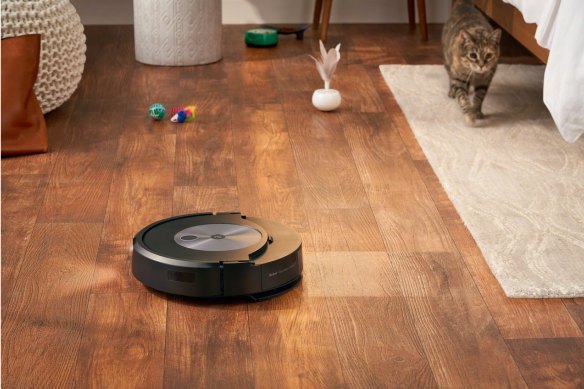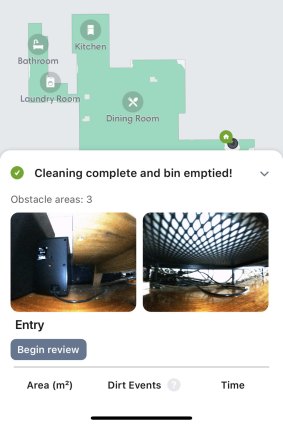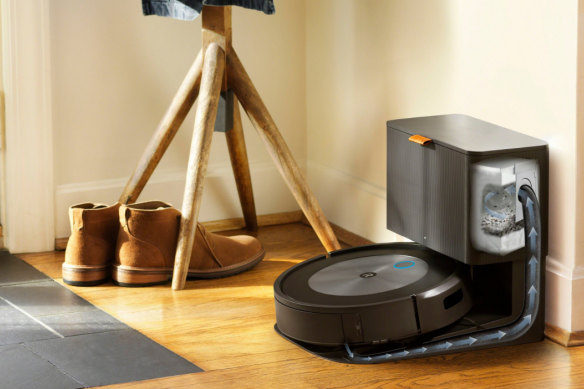This was published 1 year ago
This robot vacuum takes photos as it cleans - but can you trust it with your data?
By Tim Biggs
Twenty years after the introduction of the very first Roomba, robot vacuums have moved on from being a niche luxury to being relatively common. And its creator, iRobot, is not done adding capabilities.
The latest version expands on the robot vacuum toolset with a few new impressive tricks and smarts, but also widens the kinds of data your automated friend may scoop up alongside the dust and dirt as it moves around your home. Which is sure to be of particular concern to privacy advocates, as iRobot may soon be acquired by renowned information hoarder Amazon.

The Roomba Combo J7+ vacuums and mops, with its mop pad able to be stored on top of the unit when not needed.
At $2200 the Roomba Combo J7+ is a big investment as far as robot cleaners go, but it also pulls out all the stops. It has a retractable mop pad so it can automatically transition from vacuuming and mopping on hard floors to only vacuuming on carpets, removing the need for human intervention and ensuring your carpets stay dry. It returns to its “clean base” of its own initiative to charge, and to eject dirt into a bag so you hardly ever have to empty anything out into the bin manually. And it maintains a map of your floor that you can mark up with room names, no-go zones and extra dirty places that need special attention, for a customised clean.
All this stuff together makes for a pretty comprehensive robo-vac. You can of course just press its button and let it clean the whole floor, like you’ve always been able to with Roombas. But you can also create lists of specific cleaning jobs using the app, and activate them with a button, on a schedule or with a spoken word to Alexa or Google. So you could set it to clean under the kitchen table at 8pm every night, while you’re putting the kids to bed. Or if you happen to dump half a box of Rice Bubbles on the floor — to take a random example — you can call out and have the robot just vac that specific spot.

The Roomba wants to know if these speakers and cables will always be hidden here.
If you allow the app to monitor your location, you can even have the robot do its daily cleaning only when you’re out of the house, putting itself away when you’re home, so it seems like you just magically have clean floors.
In practice there are of course some hiccups. You still need to declutter the floor before the vacuum does its thing, because it’s better but not perfect at avoiding debris it’s not expecting to be there. It also does not have a way of replenishing its own water supply for the mop, so if you don’t remember to fill it you might get halfway to the shops and then get a notification on your phone pleading for a top-up.
And speaking of notifications, the Combo has a camera and a light on the front that it uses to detect objects it might need to avoid, but it also uses it to send you photos of stuff it’s not sure about.
That’s pretty weird for a robot vacuum (and it’s also a bit confronting to see what the deep underneath of my entertainment centre looks like), but by giving feedback on these pictures you can help it learn new kinds of temporary obstacles it might find around your home, or identify places it just shouldn’t try to go.
If an automated and Wi-Fi connected robot covered in cameras and sensors roaming your house and taking photos sounds scary to you, you’re probably not alone. But then iRobot’s always had excellent privacy credentials compared to other makers of smart home gear. It doesn’t sell your data, doesn’t send anything to iRobot without your express consent, all the tracking and mapping features are easy to turn off, and there’s a quick option to purge any information your bots have collected.

The ‘clean base’ serves as a charger and a way for the robot to transfer collected dirt to a bag.
The new robots with cameras seem to be doing things the right way as well; all images are encrypted at all times and only you can view them, unless you specifically opt to share them with iRobot via the app. The robots also get rid of any images with people in them immediately. Or you can turn its ability to capture and send you images off entirely.
Earlier this year Amazon signalled its intention to buy iRobot for $US1.7 billion ($2.5 billion), in a deal that’s currently being scrutinised by US regulators.
It remains to be seen how the data collection and privacy policies at the company would change over time assuming the transaction goes through, but the worst case scenario is obviously that Amazon would somehow use data collected by its robots to draw insights into your home life in order to sell you things.
But Barry Schliesmann, iRobot senior vice president, said the company’s commitment to transparency and security isn’t going anywhere.
“Our customers invite us into their most personal spaces — their homes — because they trust that our products will help them do more. iRobot takes that trust seriously,” he said.
“As such, security and privacy features are built into our products from the beginning of the development process. iRobot has also taken substantial measures to enhance security and privacy to ensure the company meets and exceeds regulatory requirements. None of this changes as a result of Amazon’s planned acquisition of iRobot.”
Get news and reviews on technology, gadgets and gaming in our Technology newsletter every Friday. Sign up here.